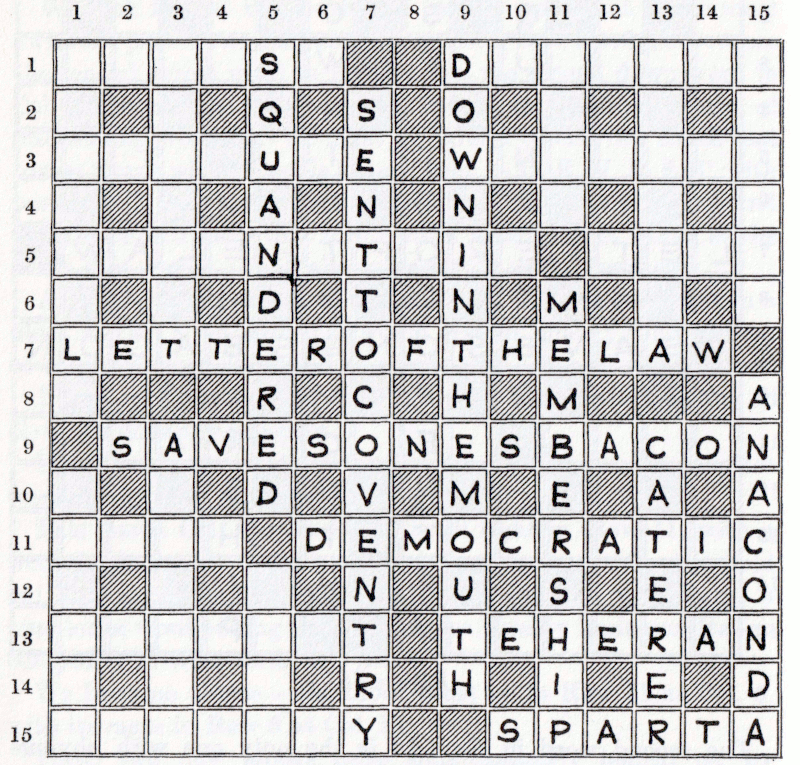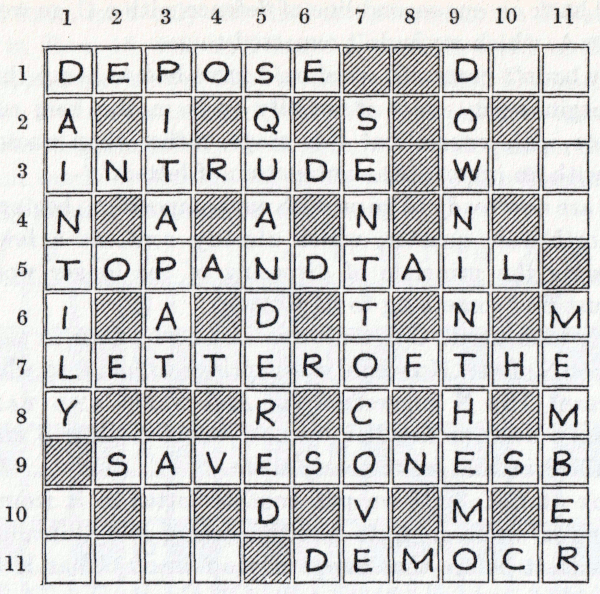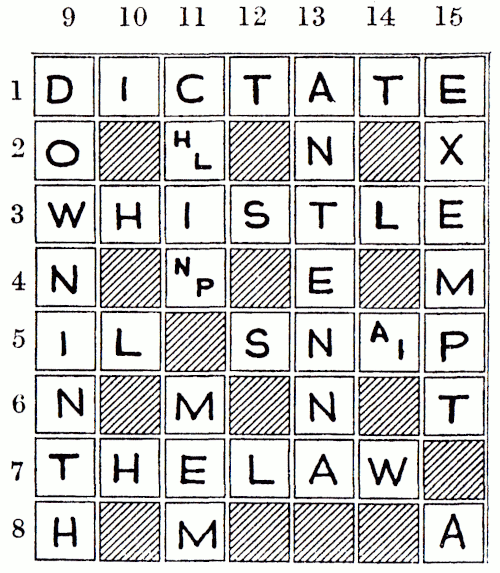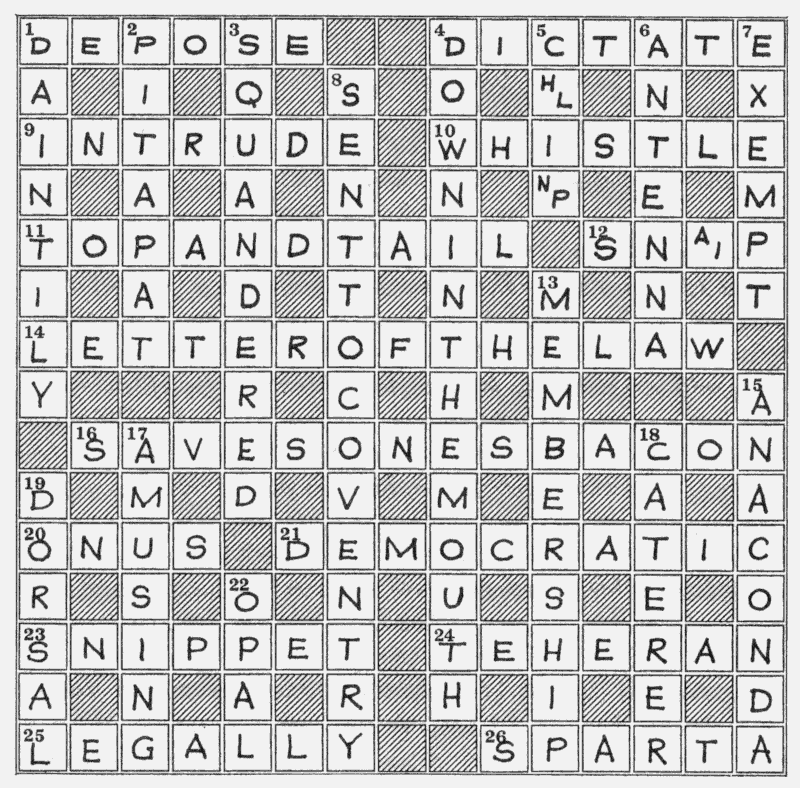Ximenes On The Art Of The Crossword
Composing an Everyman: The Diagram and Words
How do you begin to compose a crossword? Do you think of the clues first and then put the words in to fit? Is your diagram complete with blocks before you start? Do you use a lot of reference books?
Such questions are always asked whenever someone hears, with some feeling of awe, that you actually compose crosswords for a newspaper. There are, of course, many technical things which one learns with experience; but in this chapter I shall try to show that even a beginner, with a bit of help, can soon learn the principles of composition and avoid most of the snags.
I shall therefore ask you to come with me through all the stages of composition of a typical Everyman diagram, with the warning that each puzzle presents its own problems which cannot be adequately covered at one attempt.
Before we begin, we must know what we are trying to do. We want a diagram 15 squares by 15 in size, containing a symmetrical arrangement of blocks forming a pattern. By the term “symmetrical’ we mean that the design of the blocks — the black squares — will look exactly the same if the diagram is turned upside down.
The best arrangement of blocks, and the fairest for the solver, is one in which every word used will have its alternate letters exposed so as to be used by another word or words crossing them.
It follows from this that every other letter will be hidden between blocks and used only by the word or phrase to which it belongs.
The exposed letters are called checked letters, and the hidden ones unchecked letters, which for the sake of brevity we shall call “unches”.
Everyman puzzles are intended to be solvable by a person of average education on a park bench, in bed, on a train journey, and so on, without the use of a dictionary. The composer must therefore try to include in his diagram only such words or phrases as he can reasonably expect his solvers to know, including a few place-names or names of well-known people. This is an ideal which difficulties in composition may sometimes do their best to sabotage; nevertheless, we must force ourselves to shun the more recondite words.
A symmetrical pattern and well-known words, then, are our aim. What else? If we start by blocking in alternate squares on alternate lines, we shall find that we have eight 15-letter rows going across and eight 15-letter columns going down, and these must be split up to make the words workable. The most useful plan is to have two long words or phrases (of 12, 13, 14 or 15 letters each) running somewhere across the diagram, and similarly two running down it, with the rest split up into two words per row or column. This will produce fourteen answers across and fourteen down.
We are now ready to begin. We have our diagram with alternate blocks all ready, and for the purpose of easier explanation as we proceed, we shall number each square at the top from 1 to 15 and. also each square at the side similarly.
It is vital for the composer to fit in the long words before the short ones. For example, if we simply started at the top left-hand corner and began to build from it, we should soon find that we were forced to make our long words or phrases fit into impossible combinations of letters, and we should have to begin again. So we think of a familiar phrase, preferably one which looks suitable for a neat clue, the details of which we shall work — out later.
Let’s try LETTER OF THE LAW (a subpoena?). Where shall we put it? It has 14 letters, so it may go into any row, beginning at Column 1 or Column 2. If we begin it in Column 2, the checked letters will be E, T, R, F, H, L, W, of which F, H, and W might prove awkward for fitting words or phrases running down the puzzle. But if begun in Column 1, the same phrase would leave exposed the letters L, T, E, O, T, E, A, all of which are much more accommodating for intersecting words.
Which row shall we use? With such useful letters we could put it in Row 15 for the word-endings of down words, but the O might cause trouble later. Let’s try the middle, where none of the checked letters should cause any difficulty at all: say, Row 7. We block in the empty square in Column 15, and to preserve the symmetry we immediately block in the corresponding space in Row 9, Column 1. This means that the first down word in Column 1 must finish with L or L—: which is not difficult. Our diagram is now started.

Figure 12
We are going to leave the corresponding phrase for Row 9 alone for the moment. Why? Because if we put one in now, we shall have to find our two Down phrases with two letters of each already fixed, and it’s obviously easier to work with only one letter fixed.
So we glance down Columns 3, 5, 7, 9, 11, and 13 of Fig. 12, and. see whether any phrase which we’ve previously jotted down for future use will fit anywhere. What about FISH OUT OF WATER, which cries out for a nice clue about the rescue of a small boy playing near a pond? It will fit in Column 3. But wait: the awkward letter F will then be the second letter of our Row 9 phrase — not promising, if the corresponding phrase in Column 13 is awkward too.
Well, then, Column 9? That puts the F right in the middle of a yet-to-be-found phrase. Too restrictive, this; we’d better postpone the child’s accident until next week’s puzzle, and we’ll make sure that both the F’s are nice harmless unches in that one.
Let’s try again — we mustn’t let the occasional obstacle get us down. Down? DOWN IN THE MOUTH — there must be a good clue here about a careless young shaver! That will go in Column 9, with a block at the end, a corresponding block at the beginning of Column 7, and only that W in Row 3 to keep an eye on. In fact, the safest thing to do is to put a block in front of it (Column 8) and then it will have to begin a word, which is easy. So in goes the block at Row 3, Column 8, and its partner at Row 13, Column 8.
We must now find a fourteen-letter phrase for Row 9, and another for Column 7 to complete the symmetry. We’d better do Column 7 first. Why? Because we’ve got to remember that our second letter will end the word in Row 3, and our twelfth is the last letter of the word in Row 13; and if we’ve got another letter to worry about as well as the O of oF (Row 7), it’s going to be tricky. Let’s try E as the second letter. After some trial and error with fourteen-letter phrases we hit upon SENT TO COVENTRY, with a useful T to finish the first word in Row 13.
Now, are there any snags? Yes, two. The second word in Row 1 begins D: there aren’t too many words with D as the second letter, and you’ve probably used most of the obvious ones in previous puzzles. Also, the first word in Row 15 ends with Y—, which isn’t at all promising. An inspiration! Let’s put a block in front of the D and balance it with one after the Y, and we’ve killed two nuisances on one pair of chopping-blocks.

Figure 13
We are now left with the problem of finding the final phrase for Row 9, with the letters O-E now fixed in the middle. OPEN? LOVER? OVER? MAN OVERBOARD! (Chairman of directors?) — no, not enough letters: a pity, but we must use that another time. ONE’S? That’s better — there must be plenty of phrases with ONE’S in the middle. SAVES ONE’S BACON seems a nice ambiguous idea for a clue — let’s put it in and take stock of the diagram so far.

Figure 14
It’s now time for us to study the symmetry, because we’ve almost reached the stage at which we can tackle the composition one quarter at a time. We must take care, however, not to arrange the remaining blocks in such a way that each quarter is cut off from the rest of the diagram, since the solver is entitled to some help from cross-checked letters from the moment when he has solved your first clue. It isn’t fair to make him start again from scratch in each quarter.
It’s easier to build up words from first or second letters than from final or penultimate ones, which are more restrictive and impossible to look up in the dictionary, though it is possible to look them up in a rhyming dictionary; you should provide yourself with one of these. Even so, whenever possible we work from the beginnings of words. Unfortunately, this is not always possible, as you will see as we get on with the composition of this diagram.
We look first at the south-east corner, since that is the most awkward part of the diagram to compose. (This, briefly, is because the second across word in Row 15 and the second down word in Column 15 must use their checked letters as the final letters of intersecting words; so we must be careful to end our south-east corner words with versatile letters, such as D, E, N, R, S, T, with possibly C, G or L for such endings as —IC, —ING or —AL.) And experience will show that if our block arrangement works in the south-east corner, it will almost certainly work elsewhere.
A glance at Fig. 14, Row 11, shows us that we can’t put in a block at Column 8, because that would give us a fairly solid column of blocks almost dividing the puzzle into left and right halves.
If we put it in Column 10, we’ll have to find a word ending in E-O, an unhappy prospect.
If a block goes in Column 4 or 12, we shall have a three-letter word in the row, which we try to avoid.
This leaves Column 5 or 6. Column 6 is all right in Row 11, with a word beginning E—O (EVOLUTION? EMOLUMENT?) — but hold on! The corresponding block in Row 5, Column 10, would give a nine-letter word ending in T-I, and we usually limit our Italian composers in crosswords to VERDI!
We have no choice — the block must go in Row 11 at Column 5, with its mate in Row 5 at Column 11.
These two new blocks have simultaneously helped us, by breaking up Columns 5 and 11 into two words each. Are they all right? Column 5 seems fair enough, ending in E-E- (SQUANDERED? Keep it in mind by pencilling it in for the moment).
Column 11 is less easy, beginning with -E-B, but not impossible.
REMBRANDTS? The plural is not very good, and the S might be tiresome as a second letter. MEMBERSHIP, with possible play on the subject of MEMBER’S HIP (politician’s joint?) seems more promising, so in it goes, and we see what trouble it has landed us in.

Figure 15
The second word in Row 13 is the only one with obvious difficulties, so if that doesn’t work we must think again. TEHERAN fits — there surely can’t be any other word here — so put it in.
Now let’s get rid of the second word in Column 15, with one eye trained on Row 11. If the latter were DEMOCRATIC, that would give -N-C-N–, Is there such a word? Yes, ANACONDA! That’s a bit of luck, with only the final A to torment us. What word will fit in Row 15, and still leave a possible word in Column 13? SPARTA, and CATERER. That settles it: our final blocks must go above the C of CATERER and below the T in Column 3 to balance i.
Now our diagram is fully blocked-in, with each quarter deriving help from words or phrases begun elsewhere in the diagram, and the tricky south-east corner is complete.

Figure 16
We now notice that our two end words, ANACONDA and SPARTA, have used only three of the most versatile letters, the R of SPARTA and the two Ns of ANACONDA, and we have had to fall back on our second line of defence with a C, as well as a P and an A, which we hadn’t expected to use.
If it hadn’t come off, we should have had to scrap this corner and begin again, since it usually pays in the long run to be ruthless with yourself at this stage, rather than waste endless time with an impossible combination of letters.
We are now ready to go on with our composition, beginning with the north-west quarter, which already contains a few letters.
Following the principle of disposing of the longer words first, we must find something to fit Row 5.
Let’s look at it. Our tentative SQUANDERED in Column 5 will give ----N-T-I-. No single word springs to mind, so what about a phrase? The N suggests AND. And what? AND TAIL? Yes, TOP AND TAIL is familiar, so now we have Row 5 and Column 5 both filled in, and we’re nearly there.
Look at Column 3. If we put another letter in it from a word crossing it, we’re going to find the ending P-T difficult, so let’s deal with it before that happens. HOT-SPOT? That H is asking for trouble. PITAPAT looks better. Now all we need is a word in Column 1, whose first letter will help to complete Row 1, and whose third letter will give us Row 3. This is a matter of trial and error again. TELL-TALE? No good for Rows 1 and 3. PRETTILY? Still no good. DAINTILY! With that, we can have INTRUDE in Row 3, and DEPOSE in Row 1. And that, ladies and gentlemen, conquers the north-west frontier.
The north-east and south-west corners can now be tackled, in either order. In the north-east corner the only word to be wary about is the one in Column 13, ending with A. This is by no means as difficult an ending as I, O or U, though naturally far less common than E; but it will become harder if other letters are allowed to appear in the word haphazardly. So let’s think of something to put in and see whether Rows 1 and 3 are prepared to co-operate.
Lots of place-names will fit, no doubt, but since we ve already been sent to Coventry and driven to visit Teheran and Sparta we’ve done enough travelling for one puzzle.

Figure 17
Any words beginning with A and ending with A? ANTENNA might do — it could lead to a clue using ant, the composer’s favourite worker, and the reverse of ANNE, his favourite girl: and it doesn’t make the four-letter word in Row 5 impossible, so let’s have it, unless it proves a deceiver later.
Now Row 1: let’s work through the alphabet. D-A-A–? Nothing obvious there. D-B-A–? Same again. D-C-A-:? DICTATE, with a nice E at the end — put it in.
Row 3. Go through the alphabet again if you like, but WHISTLE leaps to the mind, with another useful E to finish.
Column 11. CHIP? CLIP? CHIN? An embarrassment of riches! Please yourself which you choose — it will be the one that you can clue best or the one that you haven’t used lately.
Column 15. EVENTS? ELECTS? EXERTS? let’s try to avoid the plural and third person singular if we can. ExEMPT — that’s more like it.
Finally, Row 5. SNAP or SNIP — put them both in, and make up your mind which of them to use tomorrow.
Three up and one to go!

Figure 18
So our ANTENNA proved a useful feeler after all! If it hadn’t worked, we should have tried another word. By now we have got used to finding that our first thoughts don’t always click.
We are left with one corner — the south-west — to fill in, and a glance at Fig. 16 will show that three letters only are almost irrevocably fixed, exactly as in the north-east corner which we have just done.
There are lots of words which will fit into these spaces, and it might be fun at this final stage, if we all had a go at this corner independently. You know the rules. We are going to try to avoid proper names, plurals and the third person singular of verbs too, if we can; and we are going to use familiar words.
When you are thinking of words to fit Rows 13 and 15, keep one eye riveted on the four-letter word in Column 5. Ready? Off we go!
My own version will be found in the completed puzzle (Figure 19), but don’t look at it until you’ve finished yours.
There remains one more important task before we can put the diagram aside: to fill in the clue numbers. Beginners might be grateful for precise instructions here, and the more experienced reader will perhaps excuse what may seem a statement of the obvious.
Begin at the top left-hand square of the diagram and work to the right of Row 1, putting in successive numbers at every square which begins a word or phrase, whether it goes across or down. Continue throughout the diagram, one row at a time, being careful not to miss any down words. You will find that puzzles of this type are nearly always numbered up to 25, 26 or 27.
Now look at Fig. 19 and compare its south-west corner with your own. The chances are that most of you have got completely different words from mine, which shows what variety you can get in crosswords.
The diagram is finished, but no one can yet say whether it will be a good or a bad puzzle. Given a diagram with reasonable words in it, what will make or mar the puzzle will be the standard of fairness and the entertainment value of your clues.

Figure 19